Hybrid Texts, Assembled Bodies: Michel Gondry's Merging of Camera and Dancer in "Let Forever Be"
Addie Tsai, Texas Woman's University
Abstract
Michel Gondry, a filmmaker who created and directed music videos for Propaganda Films, which produced close to a third of all music videos by 1990, began his career in music video and film during this time, where he experimented with collaging postmodern and commercial filmmaking. In 1936, cultural critic and German philosopher Walter Benjamin argued that art fundamentally changes in the age of mechanical reproduction, creating questions of authenticity and aura. This article argues that Gondry's video "Let Forever Be," for The Chemical Brothers, illustrates Benjamin's argument not only in that the digital video itself artificially reproduces the bodies embedded within it, but also in Gondry's employment of collage, special effects, and camera-enabled illusions in order to create a simulated and dream-like world.
Keywords: Michel Gondry, music video, Busby Berkeley, Walter Benjamin, simulacra
For those who came of age in the digital century, the oversaturation of technology has resulted in a doubled body, as though one hand formed of flesh and sinew curls into a very real fist, and the other of static and pixels remains disconcertingly unreal, viewed anew through the cyber lens. For those who came of age in the digital century, this ontological state is perhaps nothing to write home about. In fact, for many who came of age in the digital century, known vernacularly as millennials, this hybridized life is of no considerable consequence, mostly because it is what they have always known. But for those of us born in the MTV generation, or for those of us who are old enough to remember a time before our current digital existence, this hyperreality came upon us suddenly.1
No filmmaker has commented on this strange ontology quite like Michel Gondry2 (1963-), in that ephemeral form that continues to inform mediatized texts: the music video. This quirky and fantastically-minded French filmmaker has become well-known for the worlds he animates in his American feature films, a reputation which exploded with his hit Eternal Sunshine of the Spotless Mind. It could be argued that Gondry predicted the current state of digitization and how that state would come to affect the brain and body of viewers and makers of today's hybridized world. Contemporary filmmakers cloak cinematic texts in the conventions of the digital age, complete with CGI, FX, double exposures, parallel editing, compositing, etc. in order to simulate reality. Many of these technological cues were taken straight from Gondry; for example, the famous bullet time technique employed in The Matrix trilogy was pioneered by Gondry four years prior in the music video "Like a Rolling Stone."3 Like many other music video filmmakers of the early 1990s, Gondry experimented with filmmaking techniques through the genre of music video that he would later go on to perfect with his feature-length films. However, unlike many other music video and cinema filmmakers, Gondry consciously explored the liminal space between analog film and digital processing as a reflection of a future world, a future time, and a future embodiment.
In this article, I will discuss "Let Forever Be,"4 a music video Gondry created for The Chemical Brothers that helped cement his reputation for employing a collage of digital and film techniques. "Let Forever Be" was released in 1999, at the turn of the new millennium, and positioned Gondry as a kind of auteur-scholar commenting on the role simulacra plays in contemporary life. "Let Forever Be" contains themes Gondry would later perfect and become known for, merging his skills in art direction and special effects to call attention to the sur- and hyperreality of the digital world, and demonstrating the distance between digital art and the viewer's notion of the real. I will argue that Gondry hybridizes "Let Forever Be" by merging his own content with dance sequences choreographed by Busby Berkeley in the film musical Dames,5 collaging film and video in order to emphasize the video's dreamlike reality, and digitally manipulating the hybrid body of the main character, performed by dancer Stephanie Landwehr. I will begin by discussing the primary visual and choreographic influences in "Let Forever Be." Like Gondry, philosopher and cultural critic Walter Benjamin was able to predict, and in some senses spur, the repercussions of the move from the real to the recorded (and thus, to the digital). To that end, I will explore larger questions regarding hybrid embodiment that arise via the special effect techniques employed in "Let Forever Be." Further, I will illustrate how these questions intersect with Benjamin's forecast for transformations of art, aura, and authenticity in a technologically-advanced age.
"Let Forever Be," A Many-Splendored Thing
Due to the many morphing shots that Gondry employs, and within those shots, the many versions of bodies becoming other bodies, this section is dedicated to describing the various filmic movements in "Let Forever Be."
"Let Forever Be" opens with two concurrent frames zeroing in on a rabbi outside of a high-rise apartment building, who provides the drum beat throughout the music video. The camera briefly pans out to the street before it makes its way into a window high up in the building, and settles on our heroine, a young woman still in bed, sound asleep. The screen splits and multiplies into nine symmetrically and compositionally identical frames of the previous image, moving onward to a close up of her alarm clock. This shot splits into fourteen diamond-shaped frames of the alarm clock, some of which overlay one another, contrasting the flat and one-dimensional character of the earlier image of our heroine in bed. One by one, a hand we might presume to be that of the heroine, turns off the alarm clocks; however, the hand is revealed to belong to a dancer.
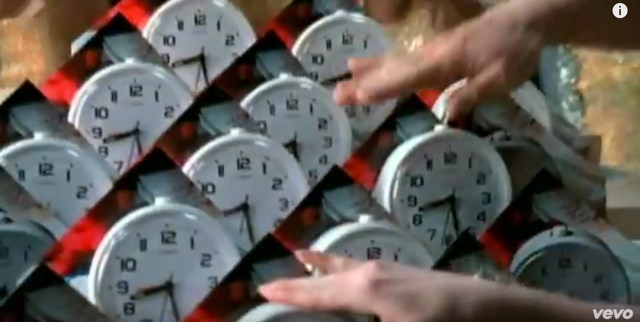
Screenshot of the many alarm clocks from the opening of the video, "Let Forever Be."
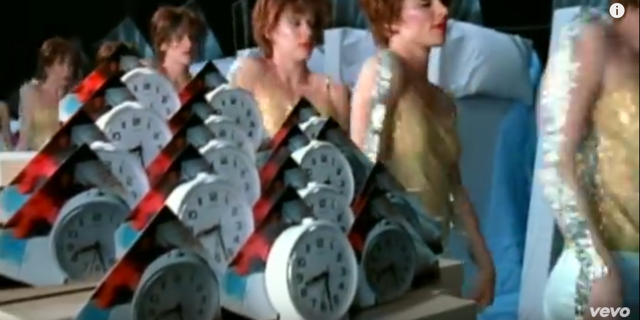
Screenshot of the dissolve between the alarm clocks in the heroine's bedroom to the multiple versions of the heroine-turned-gold lamé disco dancer from the video, "Let Forever Be."
Our new disco dancer, a redhead with bright red lipstick, appears next to a mattress similar to the one in which our heroine slept. She is joined by four or five other dancers who hold her likeness, and they all roll their shoulders backwards and forwards to the music while placing a hand on their heads, all in unison. Next they lunge towards the mattress and tuck themselves into bed. Through digital editing techniques, the shot morphs from the many sparkling dancers to our heroine in bed, who turns off the alarm clock and tilts her head back onto her pillow as though resisting waking up. She then tosses off the covers and, while seated on the edge of the bed, stretches her arms above her. The heroine's yellow tank top and white shorts replace the disco dancers' gold lamé tops and white go-go shorts (both embellished with a glittery silvery stripe down one side).
This shot dissolves back to the shimmering dancers, who are facing away from the camera with arms stretched towards the sky. They open their arms outwards and down, and then extend an arm forward with a flashy, high developpé. The dancers step away from the mirror through which we see them dance, bringing their arms above their heads in an imprecise port de bras en haut and shaking their hips to the beat. The dancers flick their right arms and right legs, pivoting to face the camera. Their movements continue in this vein, with short thrusts and swivels, and rotations of the hips, feet, and knees, before they turn three times and kneel down in front of a mirror. The image in the mirror then becomes our heroine in a shopping mall, where she races up the escalator in much more subdued attire: sleeveless pink shirt, gray pencil skirt, white stockings, and black shoes.
The shot dissolves into a kaleidoscopic image of the heroine, who appears reproduced six times on the escalator, flattened into a pattern in which her many heads are joined together at the center. Suddenly, the image is no longer of our heroine, but of our dancers lying on a platform, wearing shiny fuchsia tops, sparkly silver skirts, and dressy black flats. The dancers have one knee lifted and rotated over the other leg, while they circle their arms around, crossing over the dancer next to them. The dancers spread their legs to a wide second and stretch their arms towards us as we watch them. They stand, sashaying their hips as they walk down the platform steps, extending their movement vocabulary to include leg extensions, quick turns, and fast arm variations. The dancers walk off stage (and screen) to give the rabbi drummer, who is now also reproduced six times, his moment in the video.
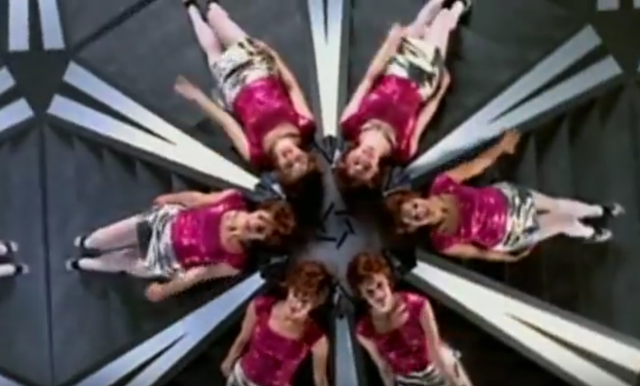
Screenshot of the disco dancers in Berkeley-esque kaleidoscope formation from the video "Let Forever Be."
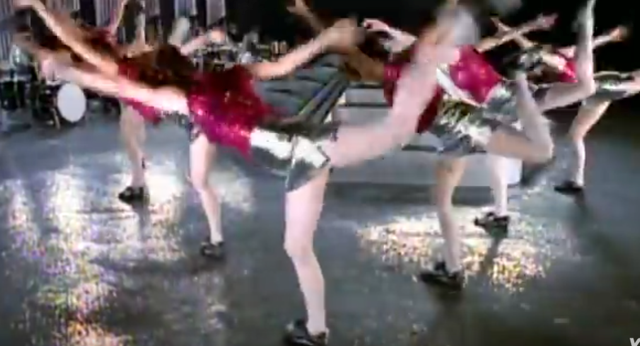
Screenshot of the disco dancers' moves from the video "Let Forever Be."
Gondry uses an initial digital editing technique to dissolve the many reproductions of the drummer back to the original shot of the rabbi playing on the street next to our heroine who is running past him to get to work on time. She briefly looks back to watch and then, leaning the opposite direction just as it seems she is about to fall, the shot changes to two dancers in a split screen, counterbalancing one another with a push and pull of the arm. One of the dancers exits, while another takes her place in the kaleidoscopic image. Just then the shot cuts back to our heroine running up the mall escalator, but not for long, as it again dissolves into a split screen of two copies of the dancer, which pans out to include the many dancers, this time from an earlier shot. The shot is familiar yet slightly altered as the women all begin to pull black turtlenecks over their shiny tops. As the women adjust the turtlenecks over their torsos, it is suddenly our heroine pulling down her own black turtleneck at her job as a cosmetics salesclerk, while chatting with a customer. Our heroine looks from the left to the right as though something feels amiss to her, and now we see the dancers again, back in their pink glittering tops, in seven diamond-shaped frames. The dancers run back to their places where we first witnessed them, pushing on the window frame in front of them, which becomes our heroine's window through which she looks out onto the street where the rabbi plays. She gazes down at her nightstand on which there is no longer an alarm clock, but instead, a tiny drum kit. She gets back into bed. The bed opens out like an accordion into many beds, in which the dancers lie sleeping in identical positions. The dancers spin out onto the stage, where they swing their hips, roll their heads around and spin again, lunging forward and backward. This part of the choreography is the first time the dancers split up briefly into two separate groups of synchronized movement. The dancers pirouette into the pirouette of our heroine on the street, before she stumbles out of the turn, and onto the dancers. The dancers hold oversized images of the heroine's head over their own as they continue to dance. Eventually, they take their positions inside multiple, diamond-cut frames that now appear handmade out of cardboard rather than created digitally. The shot then opens to a close-up of our salesclerk with the same oversized head, which shrinks to its normal size as she applies nail polish on a customer. This shot spans back out to our dancers in black turtlenecks, and then to a kaleidoscopic shot of the drummers, and finally to the rabbi, who performs in a corner of our heroine's bedroom. Our heroine, finally aware of her own nightmarish vision, covers her ears while backing away from the rabbi into her changing screen. This image triples, giving way to an image of the dancers dressed in the same clothing as the heroine. The image rotates back and forth, before it is revealed that the image isn't multiplied digitally after all, but is instead a cardboard replica of our heroine in triplicate being held over the dancers' lower bodies as they dance.
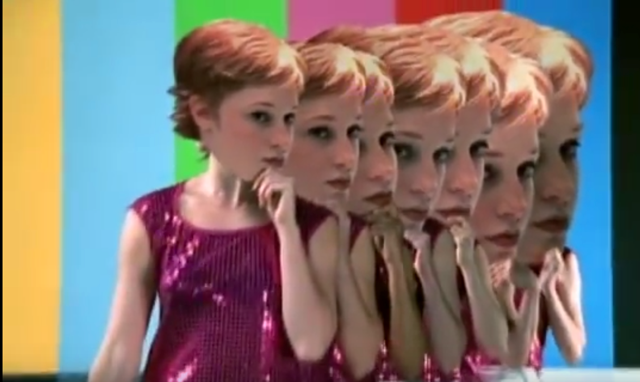
Screenshot of the disco dancers holding oversized cut-outs of the heroine's head over their own faces from the video "Let Forever Be."
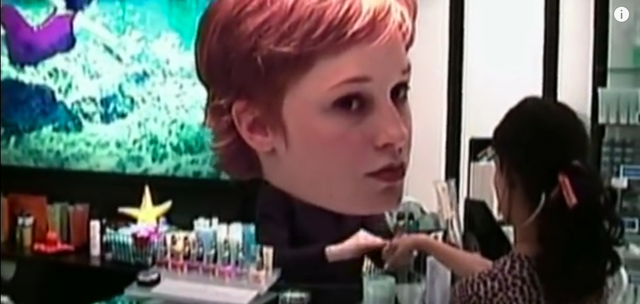
Screenshot of the heroine attending to customers at her cosmetics counter, complete with her own oversized cut-out of her face from the video "Let Forever Be."
We are now back with our heroine, the original, who is in bed again. As she blinks, the shot dissolves into the dancers, who stare at us as they hauntingly blink their glittering eyelids. The many alarm clocks now replace the blinking dancers, which are then replaced by one enormous clock. Our heroine shrinks from the clock's looming size and reminder, and covers her face with her bedspread. A pixelated, moving shot of the blanket moves back and forth across the screen until it slowly fades to black.
The (Dis)Embodiment of Flesh
In his 1931 dance review of Alfred Jackson's Girls, titled "Girls and Crisis," cultural critic Siegfried Kracauer asks: "What is it that they, like an image become flesh, embody?"6 This question applies to the cosmetics salesclerk in "Let Forever Be," who is trapped between the recurring nightmarish reality of waking to her alarm clock for her job in a shopping mall, and the dream of herself as a dozen glittering disco dancers. We as spectators are also made aware of our own hybridized selves through Gondry's manipulation of bodies. Gondry intentionally exposes the processes by which he portrays the real woman waking up from her visions of the nightmare versions of herself. Further, Gondry's works lead us to the question: what parts of our ontological lives are real within this digital experience? In the opening epigraph of his revolutionary text, Simulacra and Simulation, Jean Baudrillard quotes Ecclesiastes: "The simulacrum is never that which conceals the truth—it is the truth which conceals that there is none."7 "Let Forever Be" arrives almost a century after Walter Benjamin's haunting prediction in one of the most influential essays on the study of film and photography, "The Work of Art in the Age of Mechanical Reproduction."8 Instead of the reproducibility of the artwork calling into question the relationship art holds with authenticity, tradition, and aura, "Let Forever Be" reminds us how technology has become its own character within the artwork, through its constant, multivalent surveillance, and further, that art can also emerge from technology as witness. "Let Forever Be" illustrates the means by which our experiences as viewers have become simulated. Our heroine's dreams of her body multiplied in dazzling and psychedelic forms stands in for our own haunting visions created by an overabundance of and overexposure to digital technologies. Metaphorically speaking, we (the viewers) are the cosmetics girl waking to an army of ringing alarm clocks. We are also the disco dancers constructed from many fused appendages, leading us to question which body is ours: the one refracted in the mirror?; the one whose arms are merged into the central figure?; or the one transformed into a video image, processed through the lens, and made to seem real? Gondry's choices call into question how human bodies operate in a world entrenched in artificial media. This question has implications for millennial spectators trying to understand their bodies within this very real and hyperreal experience of the world. Gondry's constructions of relationships between the body and technology also call into question how bodies change when encountered via film and video, in the context of screendance as well as pop films. One could argue that Gondry can only hybridize the dancing body so far, because Gondry himself is not a choreographer as much as he is a director of processes in film, video, camera, and animation. I contend that the contemporary digital world that emerged from the early 1990s and continues into present-day—one for which Gondry was instrumental in building the language and aesthetic means of expression before many contemporary filmmakers—has irrevocably shifted our sense of the real body versus digitized figures in the cyber frame.9 Gondry's fusion techniques offer novel opportunities for choreographers to imagine bodies on film, and bring insights to spectators of other media, such as music video, digital video, and traditional film. These insights contribute to legitimizing dance as a unique discipline, because screendance responds to questions about the body within a culturally determinant space. Our notion of the body can be contextualized upon the cultural world our body inhabits, and screendance can explore this relationship in myriad ways.
Kracauer's question regarding Alfred Jackson's Girls—"what do they embody?"—has highlighted complications regarding women's bodies in media. Certainly critics have addressed the tendency and history of the music video genre to exploit women as sparkling objects. The current objectification of women in music videos is furthered by the history of the woman's body as duplicated by the machine.10 How has the digital age impacted our notion of the body, at once alive and processed, fragmented and re-assembled? At this point, as we further explore the implications of Gondry's world rendered real, hybrid, copied, and unreal, we can update Kracauer's question to ask the following: what does the body in "Let Forever Be," as flesh become image, broken apart, and morphed together, embody for those who can no longer distinguish between what is real, simulated, copied, and collaged? How does this multi-layered negotiation contribute to our own understanding (or as Lacan would say, misrecognition) of our own hybrid selves? This section will attend to these questions in order to better understand how, through "Let Forever Be," Gondry deployed Benjamin's theory within the burgeoning music video industry in the late-90s. Ultimately, both Benjamin's theory and Gondry's re-envisioning of his ideas contributed to changing the face of the music video genre as a whole.
Although popular media outlets such as Pitchfork Media, The A.V. Club, Huffington Post, and Paste Magazine have addressed music video as an art form, they fail to address aesthetic and theoretical approaches to music video in relation to cultural theory. Saul Austerlitz's Money for Nothing: A History of the Music Video from the Beatles to the White Stripes and Rob Tannenbaum and Craig Marks's I Want My MTV: The Uncensored Story of the Music Video Revolution provide chronological accounts of music video and MTV respectively. These accounts primarily reveal the historical and social moments that impacted music video, rather than examining the critical moves realized by creators of the form. These texts rarely mention Gondry's vast oeuvre as a music video director, and if mentioned, he is often one name in a list of directors during the height of his career. Austerlitz's text does dedicate a chapter to defending how Gondry and Spike Jonze operate as auteurs, but he mostly offers a subjective, unsupported reading of Gondry's most popular videos from the 1990s. Two particularly illuminating texts, however, offer critical analyses on music video. Rewind, Play, Fast Forward: The Past, Present and Future of the Music Video, is a media studies compilation of papers edited by Henry Keazor and Thorsten Wubbena and delivered during an international and interdisciplinary symposium in 2008 at the Goethe-University Frankfurt/Main. Giulia Gabrielli's essay, "The Contribution of Michel Gondry," explores the relationship between image and music in Gondry's music videos. In her books Experiencing Music Video: Aesthetics and Cultural Context and Unruly Media: Youtube, Music Video, and the New Digital Cinema, Carol Vernallis sets out to "take music video seriously,"11 using film and music theory to read music video as a form of text. Although these publications contribute substantially in terms of building a literature for music video as its own genre, few scholars apply post-structural media theory to music video.
Film and dance scholars have written widely about screendance, sometimes referred to as dance film, video dance, or dance for camera. Popular topics initially included film artists such as Fred Astaire, Gene Kelly, Busby Berkeley, and Charlie Chaplin. Yannis Tzioumakis and Siân Lincoln's The Time of Our Lives: Dirty Dancing and Popular Culture offers individual essays regarding the cultural impact of the iconic dance film. Further, Melissa Blanco Borelli's The Oxford Handbook of Dance and Popular Screen provides a comprehensive, contemporary discussion of dance on film that seeks to address the breadth and depth of the field, including diverse cultural narratives. The book has a section titled The Music Video and Televisual Bodies, in which dance scholars address audiovisual and televisual dance.
In terms of the dance movement vocabulary itself, many scholars have focused on music videos in which the dance used for aesthetic or narrative content is clearly seen as dance in the traditionally choreographed sense of the genre, such as that choreographed and performed by Beyoncé, Paula Abdul, Janet Jackson, and Justin Timberlake. Gondry, on the other hand, employs choreographed bodies in a nontraditional sense. The dance Gondry employs is often seen as secondary to other elements, such as technological effects or hyperreality. I contend that scholarship on the nontraditional use of dancing bodies in video is important not only for music video, but for the evolving discipline of screendance.12
While keeping Gondry's use of Berkeley's choreography in mind, the remainder of this article will focus on the relationship between "Let Forever Be" and Benjamin's theories of reproducible art. Benjamin's writings offer a frame through which to understand the Gondrian world in "Let Forever Be," which operates as a hybrid text, challenging the questions that arise for Benjamin regarding aura, authenticity,13 and tradition, particularly in terms of how video products (such as choreographic music videos)14 complicate the relationship between the artificial and the real. Many scholars have addressed the connections between Benjamin's theory and traditional film products, but few tie Benjamin's theory to the well-established form of music video.
Walter Benjamin and the Digital Age
Benjamin discussed the future of art after the invention of the photographic and film camera, quoting Franz Werfel as saying, "The film has not yet realized its true meaning, its real possibilities . . . these consist in its unique faculty to express by natural means and with incomparable persuasiveness all that is fairylike, marvelous, supernatural."15 Gondry's aesthetic choices point to the impact of advances in film and video technologies on the genre of music video. Benjamin did not live to see Gondry enact his charge regarding the future of the film medium, using the camera's malleability to create fantastical worlds that merge reality and illusion. Benjamin argued that one of the most significant changes to art in a mechanical age would be the emancipation of art from its aura, closely linked with its authenticity. Political theorist Andrew Robinson explains aura as "an effect of a work of art being uniquely present in time and space."16 Once art can be reproduced, it no longer exists in any unique present time or space, and according to Benjamin, loses its aura and authenticity.17 This is perhaps more true for the music video than for the feature film, because the music video begins its life in a televisual or cyber-enabled viewing experience, whereas the feature film is dominantly experienced in the live environment of the movie theater.
Benjamin seems ambivalent regarding the loss of aura created by mechanical reproduction. On the one hand, art in the mechanical age is emancipated from a controlled place in the tradition from which the works emerge or in which critics situate them.18 The reproducible artwork focuses instead on the copied image, creating a distracted, absent-minded viewer.19 As such, the mechanical age compromises the political role of the audience as agitator.
Benjamin's theory is useful in exploring Gondry's hybrid approach to "Let Forever Be" as a means to agitate the viewer's understanding of reality and nonreality. Whereas contemporary filmmakers use digitized techniques to connect the gaps between shots in a clear and realistic way, Gondry explicitly exposes his technological processes in order to reveal the ways in which mediatized texts are manipulated by artificial processes.
The question of aura for the screendance product includes within it larger questions than for photographs or paintings as the reproducible art products. Unlike music video, which lives in a digital medium, a live,20 authentic dance work occurs in a physical space and time, using live bodies. Although Gondry hybridizes the body with assemblages of body parts in "Let Forever Be," he does film live bodies for the video's content. How does our notion of the dancing body change within the digital video? What consequence does the loss of aura hold for a dancing body refracted, assembled, and choreographed for the video screen?
Is this the real life, or is this just fantasy?21: Gondry's morphing trickery
In separate interviews featuring Gondry and Noel Gallagher (lead singer of Oasis who provided lead vocals for "Let Forever Be"), which appeared on Director's Series, Vol. 3 – The Work of Director Michel Gondry,22 Gondry and Gallagher23 both discuss the use of film and digital processing to produce different aspects of reality and fantasy for the main character in the video:
I wanted to start to shoot on video but I was afraid because I always thought it would look ugly. I know Spike [Jonze] was doing stuff on video and I was watching that, I was like, yeah it's cool, but eh, I like film. I remember stuff like—especially the 70s TV show in England from the BBC—like the Benny Hill. When they would shoot indoors on video, it was a very crisp look, on the outdoor they would shoot on 16 millimeter camera because the video camera was too big at the time. The look was completely different but the action would match. So I had this idea to shoot half the video on film, and half on video, and do invisible transition.
—Gondry
. . . he came up with the idea that the effects would be real and the girl in her dream state, when she goes into her imaginings, the effects are created, sort of like having a cheesy 80s kind of video effect[s], it would actually be reality doing the effect.
—Gallagher
Those 80s, 70s video effect[s] when it was going into kinetoscope, or flaring, or feedback effect, I thought it would be nice to have people miming the effect as actual choreography.
—Gondry
Although influenced by Busby Berkeley's use of the body and the camera in Dames, Gondry extends this interaction, enhanced by the technological advancements of the digital age. When the wide-eyed, coquettish women in Berkeley's dance numbers suddenly notice the camera's gaze, they repurpose their props, such as lipstick, by obstructing the camera's view as though it were a potential suitor or peeping tom. The camera lens becomes personified via the various gestures the women enact towards it. The women are shown in various manners of undress, and parts of their clothing fall over the camera as if it were a spectator. Additionally, when a woman who is being watched proceeds to block the camera's view with a coquettish grin, Berkeley has turned the relationship between the camera and the female figure into a flirtatious one, potent with seduction.24
In Gondry's world the camera is similarly omnipresent and all consuming. By blending film and digital, "Let Forever Be" hybridizes the experience of the character in the video, as well as that of the spectators who are toppled to-and-fro between analog and digital processes like the rocking of a cruise ship. Is the girl's dream built from her own subconscious, or has the camera trapped the girl between real life and surreality?
Mitch Goldstein illustrates how Gondry hybridizes the text of "Let Forever Be" through film, video, and the transitions between the two. Goldstein charts Gondry's passages between reality and the dream world in his project, "'Let Forever Be' Data." His charts indicate at what points the video's lyrical, solo, or bridge sections intersect with the narrative moments of reality, nightmare, invasions (when the dreams invade reality), and "morphs" (when Gondry transitions from one world to another).25 Goldstein's data reveal how the two worlds, of reality and dreaming, gradually close in on one another—just as the transitions between film and video do. In other words, film and video become the lenses through which the viewer interprets the real and non-real. As Benjamin foresaw, technological advancements resulted in a compromising of the authenticity of art, which can be further extended to confusion regarding what version or versions of reality are authentic. Not only is the originality of the artwork impossible to discern within the technological age, but so too is the notion of what is real in our everyday lives. Certainly a body in any music video is an image of a body. In "Let Forever Be," Gondry exposes the body as artificial. Gondry uses technology to remind viewers how similar our digitally filtered experiences are to that of his salesclerk; her own dancing bodies close in on her, much the way technology surrounds us.
To heighten the welded confusion of real and digitized existence, Gondry composes the bodies in the dream state out of multiple bodies of extras, fused electronically with the duplicated bodies on screen. At times, these hybrid bodies are then reflected in a row of mirrors. Taking a cue from Berkeley's floating heads in "I Only Have Eyes For You," Gondry attaches cardboard replicas of Landwehr's face to the actual bodies of the performers.
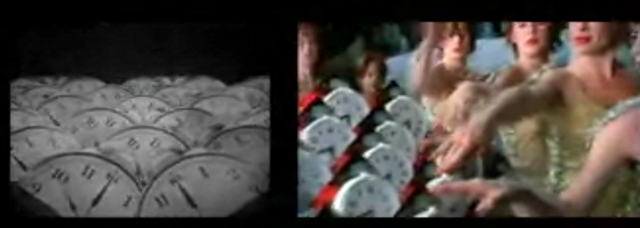
Screenshot from Digital Commons' "Digital Analyzer: Busby Berkeley vs. Michel Gondry."
In this scenario, are the women manufactured through the digital medium, or in real life? The answer is no longer easy to ascertain. In typical Gondry fashion, the heads are revealed to be artificial, as the dancers hold these heads slightly away from their faces. Additionally, Gondry fuses the heroine's real body with the bodies of other dancers who are staged to resemble her. This fusion, along with the mirror-reflected bodies and the head cut-outs, not only reveals the hybrid nature of the body in digital film, but also creates a hybrid body within the narrative of the cinematic text. These unfamiliar bodies are fragmented, spliced, and merged together into a surreal world in which reality and dream do not occupy separate spheres of existence.
I Only Have Eyes for Beautiful Dames: Berkeley Gondry-magined
On the Critical Commons website, in the "Digital Analyzer: Busby Berkeley vs. Michel Gondry,"26 the Dames sequence is played in real time next to "Let Forever Be." At 49 seconds in both films the screens fill with alarm clocks. Berkeley's alarm clocks are set against black, while Gondry's are shut off by the many disco versions of the cosmetics saleswoman. At 58 seconds, Gondry's multiplied bodies fall onto their mattresses in full costume under a blanket of strobe lighting, while Berkeley's women, configured to appear multiplied, fall into their beds. At 3:10, Gondry's dancers hold cut-outs of the heroine's face in front of their own, while in the opening of "I Only Have Eyes For You," Ruby Keeler's head is floating in the black sea where it multiplies, extending into horizontal and vertical lines that then scatter.
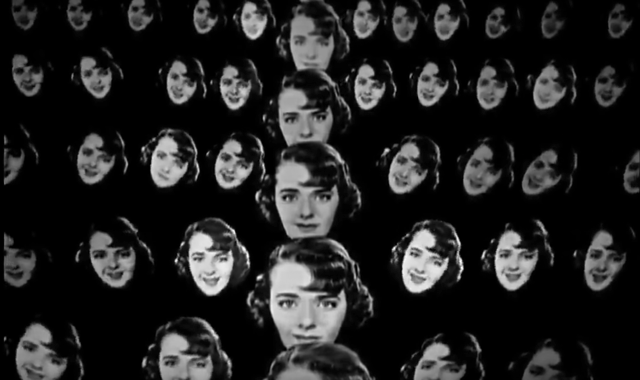
Screenshot of Ruby Keeler's floating heads in Dames, director Ray Enright (1934), and choreographer Busby Berkeley, from the "I Only Have Eyes For You" musical number, starring Ruby Keeler.
Busby Berkeley, chief choreographer of the Warner Brothers musicals from 1933 to 1937, was inspired by the military patterns of the drills he set for the United States Army. Berkeley later served as choreographer for the Ziegfield Follies, bringing precision dance, a dance form in which dancers perform as a group in unison and which emphasizes the "precision" of movement,27 to cinematic screen with accompanying camera-formed kaleidoscopes in Hollywood musicals.28 By 1930, he had choreographed twenty-one Broadway musicals. Berkeley's choreography drew audiences away from the hardship of their Depression-centered lives through song and dance, transporting them to the mesmerizing fantasy world of bodies and patterns, transformed by illusions crafted with props as well as tools solely available with the film camera. One could argue that because Berkeley could not rely on his own dance experience (he never took a single dance class), he instead became known for his quick understanding and invention of cinematic techniques, such as unusual camera angles, and the incorporation of props like rolling platforms, mirrors, and wide-angle lenses that maximize spatial possibilities in his musical numbers. He became very effective at arranging bodies on stage in geometric patterns that were then mirrored by his techniques with the camera. Because Berkeley's choreography existed solely on film, his dance sequences reflect Benjamin's argument that a mechanically reproducible work of art emancipates itself from the notion of authenticity. Not only does Berkeley's artwork lack an aura, but the dancers in his films lose their uniqueness as individual performers, appearing only as filtered and processed forms.
Presumably, Gondry was drawn to Berkeley for his privileging of visual and bodily architecture through a camera-enabled world. In an interview, Gondry expressed a shared interest with Berkeley in the potential that choreography has for designing dynamic spatial patterns:
I would see choreography that was boring and conventional and all about close-up as to me choreography should be about architecture and wide shot and geometrical pattern and not about putting your guts out. It's about expressing shapes with your body without showing expression in your voice.29
Berkeley popularized dance for a mixed audience at the transition between silent films and "talkies." What does Gondry's work with Berkeley illuminate regarding how filmmakers use the dancing body to represent the pattern of the machine, or further, the body as re-interpreted through mechanic processes of film and video? Given the already hybrid nature of music video, which is further hybridized by Gondry's own aesthetic and technological choices, "Let Forever Be" brings out intersections between live bodies and bodies as re-presented on screen.
Benjamin's text from 1936 intersects with the end of Berkeley's reign at Warner Brothers in 1939. "The Work of Art in the Age of Mechanical Reproduction" was published in Germany while Berkeley used new film cameras to transform bodies into pinwheels in cinemas across the United States. Once a copy can be perfected through the art of technology, Benjamin contends that the question of authenticity is evoked. In the world of instant copies, what is original? In Benjamin's own words, "the presence of the original is the prerequisite to the concept of authenticity";30 thus "the technique of reproduction detaches the reproduced object from the domain of tradition."31 I would argue that by embedding references to Dames within "Let Forever Be," Gondry not only links himself to a tradition, but also connects his cinematic text to other choreographic texts. Gondry nods to Berkeley through his employment of fragmentation, synchronization, and multiplication of the body as viewed through the lens of the camera. Benjamin could not have predicted the ease with which worlds can be recreated, distorted, and double-exposed through the camera, as well as via computers that process and edit video footage.
With the digital era, new editing and processing possibilities inspired complex investigations of the relationship between dancer and machine. Earlier choreographers such as Berkeley could only mimic human-machine interactions using live bodies in front of a film camera. Although Berkeley used the camera and illusion to change the way the body was seen, the dancers themselves were real, manufactured to resemble one another to such a precise approximation that they represented the efficiency of the machine found in assembly line production. Gondry was able to move beyond Berkeley's machinic metaphors, and fuse bodies digitally onto the real bodies performing the dance in "Let Forever Be."
I propose that Gondry hybridizes "Let Forever Be," using key aesthetic and visual elements from two dance sequences in Dames, namely "Dames" (the title sequence), and "I Only Have Eyes For You." The musical composition "I Only Have Eyes For You" further reveals the complexities of technological reproduction. The song, composed by Harry Warren and lyricist Al Dubin, was written specifically for Dames and has been used in countless films and covered by numerous artists over the last half century. As one can see, the implications of technology are as endless and eternal as the ongoing life of the machine. Many music critics have stated that the target audience for music videos at the time of release of "Let Forever Be" consisted of young white men between eighteen and twenty-four years of age.32 These men arguably sought out music video as a preference over live dance performances because the music videos promoted the musical groups they were avidly listening to at the time. Evidence suggests that young men in this time period displayed a lack of interest in dance, particularly as performed in Hollywood musicals.33 Gondry employs choreography less familiar to his target audience than that which audiences might be more familiar with from televised productions such as the Rockettes in the Macy's Day parade. Gondry makes a unique contribution by subversively incorporating the visual patterns and movements of precision dance for a contemporary audience. Although the presumably post-adolescent young white men that view Gondry's video may not have particular familiarity or interest in the Berkeley referent, Gondry still capitalizes on the history of using the female body as a backdrop. Gondry utilizes technology for aesthetic purposes, as well as to comment upon the implications of technologically mediated artwork.
Berkeley's dance sequences discussed above provided the primary visual and choreographic inspirations for Gondry in "Let Forever Be." According to film critic Kevin Lee,
["I Only Have Eyes For You" is] ostensibly a cinematic love letter to Warner Brothers stalwart Ruby Keeler, [that] blossoms into a many-splendored meditation in movement: the star image as that well-worn paradox of intimate and accessible, unequivocally singular and infinitely reproducible. Along these lines, Berkeley's compositions oscillate between close-up and wide shot, human figures dissolving into abstract geometries. These themes are pushed to even greater visual extremes in the climactic title number, a celebratory confluence of capitalist desire for abundance, sexual provocation/objectification, avant garde cubism and quasi-fascist pageantry and precision – in other words, it encapsulates the major themes of the 1930s better than any other ten minutes in cinema.34
Lee's assertion regarding this sequence mirrors the widely discussed relationship between the precision dance movement of this era and capitalist abundance. The camera enables Berkeley's dissolutions between human figures and abstract geometries.
Taken a step further, in Berkeley's use of staging and choreographing bodies around the lens, the camera is itself a body, used to fragment and duplicate the bodies on screen. In "I Only Have Eyes For You," Berkeley uses the viewer's awareness of the lens to emphasize the voyeuristic nature of the camera and videographer while creating a transition between choreographic phrases. For example, throughout the sequence, many women perform intimate routines on screen, such as bathing or primping themselves in the mirror. Periodically, the subject of a close-up will suddenly notice the lens's focus on her and physically conceal herself from further spectatorship. Other moments reveal the figure closest to the camera taking the powder puff she primps herself with to cover the camera lens, as well as a woman admiring herself at her vanity spraying a puff of vapor from the perfume bottle next to her onto the lens, creating an obscuring fog. These transitions, among others, transform the camera into a titillated viewer. Gondry extends Berkeley's approach to the camera as voyeur in the digital age, personifying it as the surveilling eye of a security camera in the lobby of a building, monitored from a control center. Both artists call explicit attention to the reproducibility of art through the fusion of the camera and body.
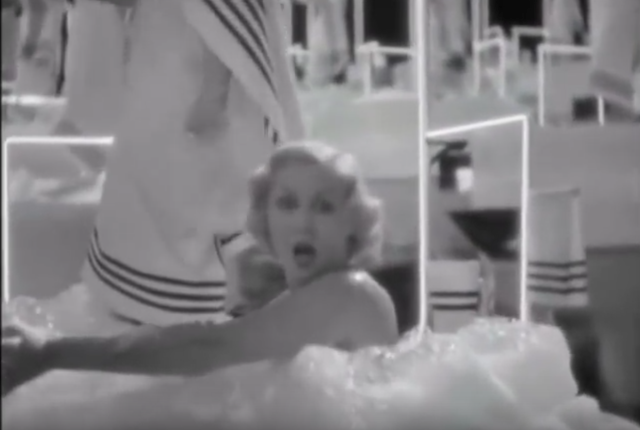
Screenshot of the primping scene in Dames, director Ray Enright (1934), and choreographer Busby Berkeley, from the "I Only Have Eyes For You" musical number.
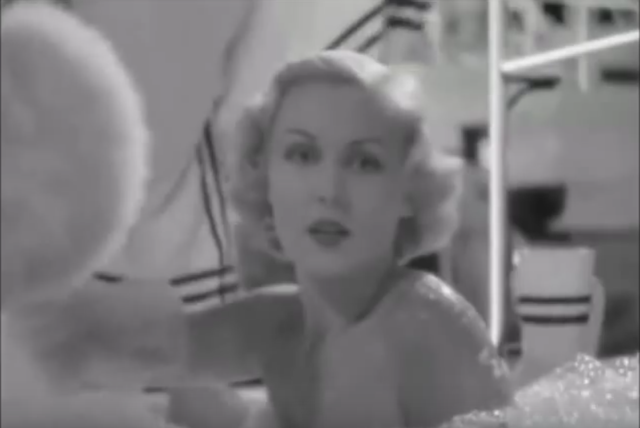
Screenshot of the primping scene in Dames, director Ray Enright (1934), and choreographer Busby Berkeley, from the "I Only Have Eyes For You" musical number.
Through multiple hybrid layers in "Let Forever Be," Gondry addresses Benjamin's questions and adds his own, exploring what uniqueness a body can have when reproduced within media products such as music video. Gondry's questions are a refreshing shift from early contributions to music video, in which filmmakers creating videos for male musical artists incorporated women as backdrops to sell records to their hard rock teenaged fans. Aside from the drummer, "Let Forever Be" is a woman-based landscape. Gondry uses his technological wizardry to expose the questions that arise when female flesh is resituated within cyberspace. He offers a new theoretical lens with which to activate Benjamin's ideas regarding the original and the copy, and explores the implications of the dancing and hybrid body within music video. Gondry does not offer easy answers to Benjamin's questions, but he does expose how the half-real, half-simulated world in which we live affects our own embodied relationships to the world. In my vision, this video explores a relationship to the body that has potential to be furthered within screendance scholarship and productions.
Biography
Addie Tsai is a writer, artist, and professor. She currently teaches Literature, Creative Writing, and Dance at Houston Community College. She also teaches at The Jung Center and Texas Woman's University, where she also pursues a Ph.D. in Dance. Addie researches how pop cultural uses of dance demonstrate how subjects negotiate identities dealing with race, gender, class, and sexuality. Addie received an MFA in Poetry from Warren Wilson College. She has collaborated on dance theater productions, most notably with Dominic Walsh Dance Theater, as Co-conceiver of Victor Frankenstein and Narrative Collaborator on Camille Claudel. Addie's fiction, nonfiction, and poetry have been published in such journals as The Volta, The Offing, American Letters & Commentary, and The Collagist.
Email:
Web: http://addietsai.org
References
Arnett, J. J. "The Sounds of Sex: Sex in Teens' Music and Music Videos." Sexual Teens, Sexual Media: Investigating Media's Influence on Adolescent Sexuality. Eds. J. D. Brown, J. R. Steele, & K. Walsh-Childers. Mahwah and London: Lawrence Earl, 2002. 253-264.
Aubrey, Jennifer S. & Cynthia M. Frisby. "Sexual objectification in music videos: A content analysis comparing gender and genre." Mass Communication and Society, 14.4 (2011): 475-501. http://dx.doi.org/10.1080/15205436.2010.513468
Auslander, Philip. Liveness: Performance in a Mediatized Culture. London: Routledge, 1999.
Austerlitz, Saul. Money for Nothing: A History of the Music Video from the Beatles to the White Stripes. New York: Continuum, 2007.
Baudrillard, Jean. Simulacra and Simulation. Ann Arbor: University of Michigan, 1980.
Benjamin, Walter. [1968] "The Work of Art in the Age of Mechanical Reproduction." The Routledge Critical and Cultural Theory Reader. Eds. Neil Badmington and Julia Thomas, New York: Routledge, 2008. 34-56.
Craig, Maxine Leeds. Sorry I Don't Dance: Why Men Refuse to Move. London: Oxford University, 2013. http://dx.doi.org/10.1093/acprof:oso/9780199845279.001.0001
"Dames." Chor. Busby Berkeley. 2011. YouTube.
"Difference Analyzer: Busby Berkeley vs. Michel Gondry." Critical Commons. Posted 2013. http://www.criticalcommons.org/Members/ccManager/clips/difference-analyzer-busby-berkeley-vs-michel
"THE EVOLUTION OF MUSIC VIDEOS – 1990S." Digital Canvas. Posted 2015. http://digitalcanvas.co/2015/03/11/the-evolution-music-videos-1990s/
Director's Series, Vol. 3 – Director Michel Gondry. Dir. Lance Bangs. New York: Palm Pictures. 2004. DVD.
"I ONLY HAVE EYES FOR YOU from 'DAMES' with RUBY KEELER and DICK POWELL 1934." Dir. Ray Enright. 2011. YouTube.
Gabrielli, Guilia. "An Analysis of the Relation between Music and Image: The Contribution of Michel Gondry." Rewind, Play, Fast Forward: The Past, Present, and Future of Music Video. Eds. Henry Keazor and Thorsten Wubbena. London: Transaction Publishers, 2010. 89-109. http://dx.doi.org/10.14361/9783839411858-006
Goldstein, Mitch. "'Let Forever Be' Data." Mitch Goldstein: Through Process, My MFA Thesis in Graphic Design. Posted 2012. http://mfa.mitchgoldstein.com/let-forever-be---data/
Gondry, Michel. The Chemical Brothers – Let Forever Be. Dir. Michel Gondry. 2009. YouTube.
Gow, Joe. "Reconsidering gender roles on MTV: Depictions in the most popular music videos of the early 1990s." Communication Reports 9.2 (1996): 151-161.
Kappenberg, Claudia. "Does Screendance Need to Look Like Dance?" International Journal of Performance Arts and Digital Media 5.2-3 (2009): 89-105.
Kiang, Jessica. "'The Matrix' Anniversary: 7 Pre-Bullet Time VFX Effects that Blew Our Minds". The Playlist. Posted 3 Apr. 2014. http://blogs.indiewire.com/theplaylist/the-matrix-anniversary-7-pre-bullet-time-cg-effects-that-blew-our-minds-back-when-20140403
Kracauer, Siegfried [1931]. "Girls and Crisis." The Weimar Republic Source Books. Eds. Anton Kaes, Jay Martin, and Edward Dimendberg, Berkeley: University of California Press, 1995. 565-566.
____. The Mass Ornament: Weimar Essays. Cambridge: Harvard University, 1995.
Lee, Kevin. "938. Dames (1934, Ray Enright, Busby Berkeley)." Shooting Down Pictures. Posted 12 Dec. 2007. http://alsolikelife.com/shooting/2007/12/938-dames-1934-ray-enright-busby-berkeley/
Levy, Glen. "The 30 All-TIME Best Music Videos," TIME, Posted 26 July 2011. http://entertainment.time.com/2011/07/28/the-30-all-time-best-music-videos/slide/chemical-brothers-let-forever-be-1999/
Mercury, Freddie. "Bohemian Rhapsody." A Night at the Opera. London: Roy Thomas Baker, 1975.
Mitchell, W. J. T. "The Keywords of Media Theory." The University of Chicago: Theories of Media. Posted 2004. http://csmt.uchicago.edu/glossary2004/navigation.htm
Mottram, James. The Sundance Kids: How the Mavericks Took Back Hollywood. London: Faber and Faber, 2007.
Mulvey, Laura. "Visual Pleasure and Narrative Cinema." Screen, 16.3, (1975): 6-18. http://dx.doi.org/10.1093/screen/16.3.6
Pells, Richard. Modernist America. New Haven: Yale University, 2011.
Plagenhoef, Scott. "The Top 50 Music Videos of the 1990s." Pitchfork Media. Posted 23 Aug. 2010. http://pitchfork.com/features/staff-lists/7849-the-top-50-music-videos-of-the-1990s/5/
Reichert, Tom and Jacqueline Lambiase. Sex in Consumer Culture: The Erotic Content of Media and Marketing (Routledge Communication Series). New York: Routledge, 2005.
Robinson, Andrew. "Walter Benjamin: Art, Aura and Authenticity (An A to Z of Theory)." Ceasefire Magazine. Posted 14 Jun. 2013. https://ceasefiremagazine.co.uk/walter-benjamin-art-aura-authenticity/
Smith, Imogen Sara. "Busby Berkeley (1895-1976)." Dance Heritage Coalition. Posted 2012. http://www.danceheritage.org/treasures/berkeley_essay_smith.pdf
Sontag, Susan. On Photography. New York: Picador, 1977.
Tannenbaum, Rob and Craig Marks. I Want My MTV: The Uncensored Story of the Music Video Revolution. New York: Plume, 2012.
Taylor, Yuval and Jake Austen. Darkest America: Black Minstrelsy from Slavery to Hip-Hop. New York: Norton, 2012.
Vernallis, Carol. Experiencing Music Video: Aesthetics and Cultural Context. New York: Columbia University, 2004.
Vincent, Richard C., Dennis K. Davis, and Lilly Ann Boruszkowski. "Sexism on MTV: The Portrayal of Women in Rock Videos." Journalism Quarterly 64.4 (Winter 1987): 750-941. http://jmq.sagepub.com/content/64/4/750.extract
Notes
Jean Baudrillard, Simulacra and Simulation, 1. I speak here of reality and hyperreality as defined by Baudrillard: "Today abstraction is no longer that of the map, the double, the mirror or the concept. Simulation is no longer that of a territory, a referential being, or a substance. It is the generation by models of a real without origin or reality: a hyperreal. The territory no longer precedes the map, nor survives it. Henceforth, it is the map that precedes the territory – precession of simulacra – it is the map that engenders the territory …".↩
Gondry began his career directing music videos for Propaganda Films, cofounded by David Fincher. For a history of Propaganda's contribution to music video see James Mottram, The Sundance Kids, 149-168. For a comprehensive source on Gondry's career, refer to Lance Bangs, Director's Series, Vol. 3. For an extensive account of MTV, see Rob Tannenbaum and Craig Marks, I Want My MTV.↩
Jessica Kiang, "'The Matrix' Anniversary."↩
Michael Gondry, "Let Forever Be." For more information on the impact of "Let Forever Be" see Scott Plagenhoef, "The Top 50 Music Videos of the 1990s," and Glen Levy, "The 30 All-TIME Best Music Videos." For more on the 1990s in music video history, known as the "era of the director," a consequence of MTV listing the director in the credits of music videos, see: Digital Canvas online, "The Evolution of Music Videos–1990s."↩
Chor. Busby Berkeley, Dames.↩
Siegfried Kracauer, "Girls and Crisis," 565.↩
Baudrillard, 1.↩
Walter Benjamin, "The Work of Art in the Age of Mechanical Reproduction," 34.↩
This may seem an exaggeration of Gondry's impact, because even after almost thirty years of creating music videos, short films, and feature-length films, his work remains under examined in media studies and interdisciplinary scholarship. For further details on Gondry's aesthetic contributions, see Giulia Gabrielli, 89-109.↩
See Jennifer S. Aubrey and Cynthia M. Frisby, "Sexual objectification in music videos"; Joe Gow, "Reconsidering gender roles on MTV"; Richard C. Vincent, et al, "Sexism on MTV"; Jeffrey Jensen Arnett, "The Sounds of Sex"; and Yuval Taylor and Jake Austen, Darkest America: Black Minstrelsy from Slavery to Hip-Hop, for a few examples.↩
Carol Vernallis, Experiencing Music Video, x.↩
See Claudia Kappenberg, "Does Screendance need to look like dance?" 89-105.↩
See W. J. T. Mitchell, "Keywords Glossary," The University of Chicago School of Media Theory for a useful definition of the term "authenticity" in relation to Benjamin's work.↩
A choreographic music video is "a label for this supposed new genre which falls into a content-based classification. Here the bodies that are developing a choreographic performance compose the content" (Gabrielli, 101).↩
Benjamin, 41.↩
Andrew Robinson, "Walter Benjamin: Art, Aura, and Authenticity."↩
Benjamin, 36.↩
Idem., 39.↩
Idem., 49.↩
I use the word "live" here as a distinction from the recorded, as articulated by Steve Wurtzler, quoted in Philip Auslander, Liveness: "As socially and historically produced, the categories of the live and the recorded are defined in a mutually exclusive relationship, in that the notion of the live is premised on the absence of recording and the defining fact of the recorded is the absence of the live." (3). See Auslander for a further historical and theoretical examination of liveness and mediatization.↩
Freddie Mercury, Bohemian Rhapsody.↩
Bangs, Director's Series, Vol. 3.↩
Ibid.↩
Laura Mulvey, "Visual Pleasure and Narrative Cinema," 6-18. In Mulvey's discussion of the gaze as employed by filmmakers such as Berkeley, she quotes Budd Boetticher: "What counts is what the heroine provokes, or rather what she represents. She is the one, or rather the love or fear she inspires in the hero, or else the concern he feels for her, who makes him act the way he does. In herself the woman has not the slightest importance" (20).↩
Mitch Goldstein, "'Let Forever Be' Data."↩
Critical Commons, "Difference Analyzer: Busby Berkeley vs. Michel Gondry."↩
Siegfried Kracauer, The Mass Ornament: Weimar Essays. Kracauer's discussion of precision dance is useful in understanding the lineage from which Berkeley's choreography was born.↩
Richard Pells, Modernist America, 186.↩
Bangs, Director's Series, Vol. 3.↩
Benjamin, 36.↩
Idem., 37.↩
See Tom Reichert and Jacqueline Lambiase, Sex in Consumer Culture, and Rob Tannenbaum and Craig Marks, I Want My MTV.↩
See Maxine Leeds Craig, Sorry I Don't Dance: Why Men Refuse to Move, for a historical tracing of American men's disinterest in dance during the 20th century. See also Auslander for an explanation of the gradual trend away from attending live performance, and an increase in mediatized consumption from the 20th to the 21st centuries.↩
Kevin Lee, "938. Dames."↩
